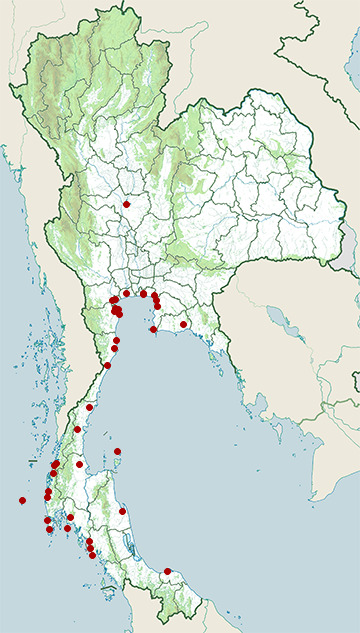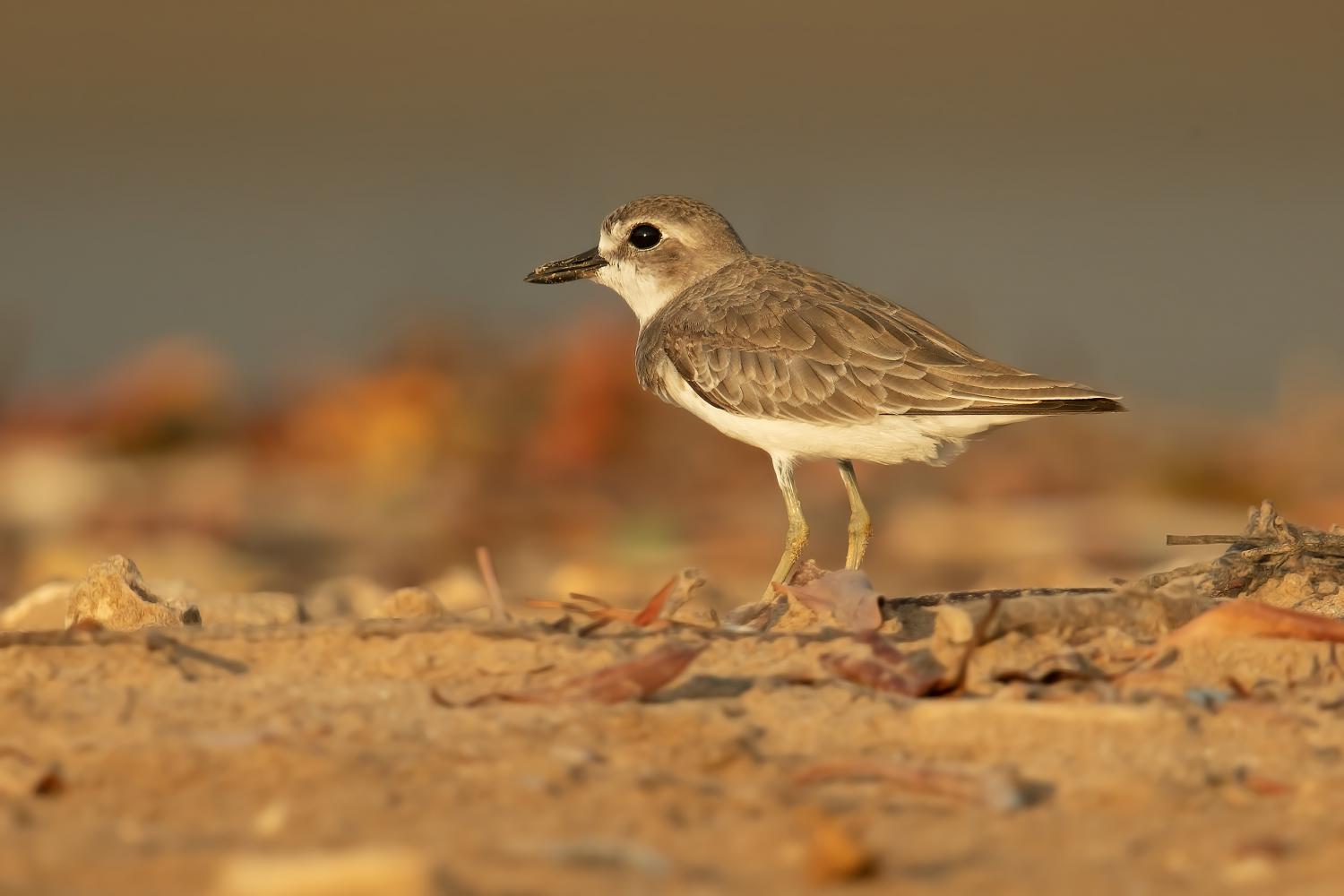Species of Thailand
Greater sand plover
Charadrius leschenaultii
Rene Primevere Lesson, 1826
In Thai: นกหัวโตทรายใหญ่
The greater sand plover (Charadrius leschenaultii) is a small wader in the plover family of birds. The spelling is commonly given as "greater sandplover" or "greater sand-plover", but the official British Ornithologists' Union spelling is "Greater Sand Plover". The genus name Charadrius is a Late Latin word for a yellowish bird mentioned in the fourth-century Vulgate. It derives from Ancient Greek kharadrios a bird found in ravines and river valleys (kharadra, "ravine"). The specific leschenaultii commemorates the French botanist Jean Baptiste Leschenault de la Tour.
Distribution
It breeds in the semi-deserts of Turkey and eastwards through Central Asia. It nests in a bare ground scrape. This species is strongly migratory, wintering on sandy beaches in East Africa, South Asia and Australasia. It is a rare vagrant in western Europe, where it has been recorded as far west as Iceland. It has been spotted twice in North America, the most recent being on May 14, 2009, in Jacksonville, Florida.
Subspecies
There are three subspecies: The nominate, C. l. columbinus and C. l. scythicus. The last was known as C. l. crassirostris until it was established that this name is pre-occupied by a subspecies of Wilson's plover, C. w. crassirostris.
Description
This chunky plover is long-legged and thick-billed. Breeding males have grey backs and white underparts. The breast, forehead and nape are chestnut, and there is a black eye mask. The female is duller, and winter and juvenile birds lack the chestnut, apart from a hint of rufous on the head. Legs are greenish and the bill black.
In all plumages, it is very similar to lesser sand plover, Charadrius mongolus. Separating the species may be straightforward in mixed wintering flocks on an Indian beach, where the difference in size and structure is obvious; it is another thing altogether to identify a lone vagrant to western Europe, where both species are very rare. The problem is compounded in that the Middle Eastern race of the greater sand plover is the most similar to the lesser species.
Ecology
Its food consists of insects, crustaceans and annelid worms, which are obtained by a run-and-pause technique, rather than the steady probing of some other wader groups.
Its flight call is a soft trill.
The greater sand plover is one of the species to which the Agreement on the Conservation of African-Eurasian Migratory Waterbirds (AEWA) applies.
This article uses material from Wikipedia released under the Creative Commons Attribution-Share-Alike Licence 3.0. Eventual photos shown in this page may or may not be from Wikipedia, please see the license details for photos in photo by-lines.
Category / Seasonal Status
Wiki listed status (concerning Thai population): Winter visitor
BCST Category: Recorded in an apparently wild state within the last 50 years
BCST Seasonal status: Non-breeding visitor
Scientific classification
- Kingdom
- Animalia
- Phylum
- Chordata
- Class
- Aves
- Order
- Charadriiformes
- Family
- Charadriidae
- Genus
- Charadrius
- Species
- Charadrius leschenaultii
Common names
- English:
- Greater sand plover
- Large sand dotterel
- French: Pluvier du désert
- Thai: นกหัวโตทรายใหญ่
Subspecies
Charadrius leschenaultii columbinus (nominate), Johann Georg Wagler, 1829
Charadrius leschenaultii crassirostris, Nikolai Alekseevich Severtsov, 1873
Charadrius leschenaultii scythicus, Caio Jose Carlos, Cees S. Roselaar & Jean-François Voisin, 2012
Conservation status

Least Concern (IUCN3.1)
Photos
Please help us review the bird photos if wrong ones are used. We can be reached via our contact us page.
Range Map

- Amphawa District, Samut Songkhram
- Ban Laem District, Phetchaburi
- Bang Pakong District, Chachoengsao
- Bang Phra Non-Hunting Area
- Bang Pu Recreation Centre
- Bueng Boraped Non-Hunting Area
- Chaiya District, Surat Thani
- Hat Chao Mai National Park
- Khao Lak - Lam Ru National Park
- Khao Sam Roi Yot National Park
- Khlong Nakha Wildlife Sanctuary
- Khura Buri District, Phang Nga
- Klaeng District, Rayong
- Ko Libong
- Laem Pak Bia
- Mueang Chonburi District, Chonburi
- Mueang Krabi District, Krabi
- Mueang Pattani District, Pattani
- Mueang Phetchaburi District, Phetchaburi
- Mueang Phuket District, Phuket
- Mueang Prachuap Khiri Khan District, Prachuap Khiri Khan
- Mueang Samut Sakhon District, Samut Sakhon
- Mueang Samut Songkhram District, Samut Songkhram
- Pak Phanang District, Nakhon Si Thammarat
- Pak Thale
- Pathio District, Chumphon
- Phi Phi Islands
- Pran Buri Forest Park
- Samut Prakan Province
- Sattahip District, Chonburi
- Sawi District, Chumphon
- Sikao District, Trang
- Similan Islands
- Sirinat National Park
- Suk Samran District, Ranong
- Takua Pa District, Phang Nga
- Than Sadet - Koh Pha-Ngan National Park


